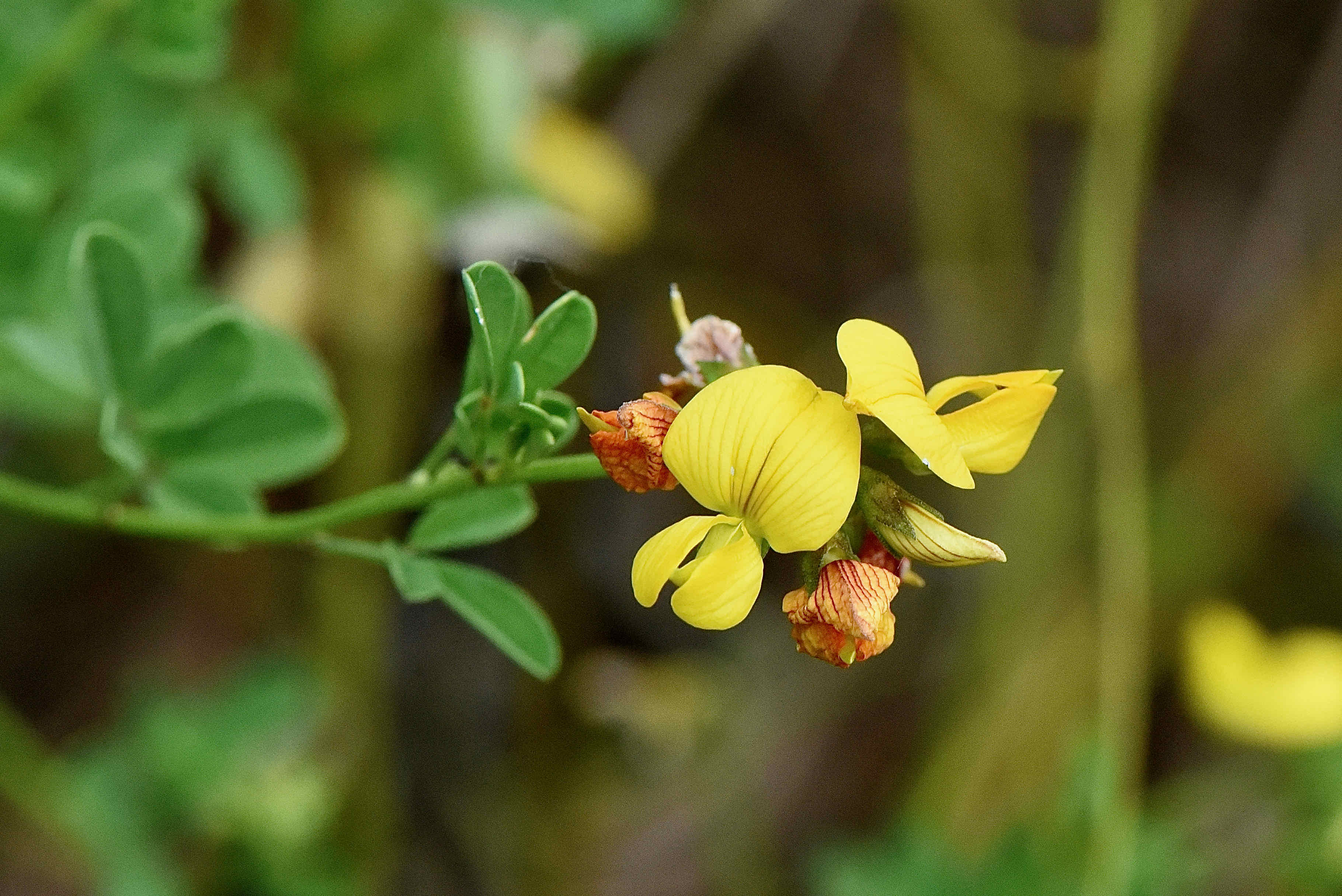
Low Rattlebox, photographed at Crystal Lake Sand Pine Scrub, Pompano Beach, Broward County, in March 2022.
There are something like 600 members of the Crotalaria genus worldwide of which two are Florida natives, rabbit bells, C rotundifolia, and low rattlebox, C pumila. Both are fairly common, rabbit bells especially so; low rattlebox a little less, at least by our observations.
Our subject for today: low rattlebox. It gets the name because it tends to be smaller than most Crotalarias but shares the distinctive rattle-like seed pod that gives the genus its name. Crotalaria in Greek means rattle, pumila, dwarf.
In Florida, it’s primarily found in coastal counties along the eastern seaboard, from Volusia County south into the Keys, plus Sarasota County on the west coast. The Institute for Regional Conservation in Delray Beach says the Sarasota County plants might be escapees from cultivation that established themselves in the wilds of the county. Some sources include both Collier and Alachua counties within low rattlebox’s range, some do not.
But beyond Florida, low rattlebox’s range is a little odd. You’d think low rattlebox would be found in other southeastern states; it’s not. It’s actually a plant of the Southwest —Oklahoma and Texas, Utah, Arizona and New Mexico, with Maryland thrown in for good measure. It’s an introduced plant in Hawaii.
Low rattlebox extends through the Caribbean, including the Bahamas, Mexico, Central America and South America to Paraguay and Argentina.
Favorite habitats in Florida include pinelands, coastal dunes and coastal thickets. It can grow low, as a ground cover forming open patches, or it can be somewhat erect, hitting maybe a foot off the ground. It is a perennial in warmer climes, like Florida, or an annual farther north.
Low rattlebox has compound leaves, each with three small leaflets round to elliptical in shape with a rounded tip, or apex, arranged alternately along the stem. The upper side of the leaflets are smooth, the underside hairy. Leaflets are the same size, a half-inch to three-quarters of inch long; the middle leaflet can be larger than the other two.
Its flowers are an eyecatching yellow-orange with a bit of red in them, each with five petals. In South Florida, low rattlebox blooms year-round. The flowers give way to stubby, hairy seed pods that go from green to brown when ripe, and inflate as they get older. The seeds become loose — shake a mature pod and it will rattle. Eventually the pods will pop open with enough force to broadcast their contents several feet.
Low rattlebox’s compound leaves separate it from rabbit bells, the other native Crotalaria; its low habit separates it from the larger, non-native members of Crotalaria found in Florida that have compound leaves, such as smooth rattlebox, C pallida var. obovata.
The Crotalarias found in South Florida, native and non-native, are host plants for the caterpillars of the bella moth, and low rattlebox is no exception. These little bugs are after pyrrolizidine alkaloids that Crotalarias manufacture the way monarch caterpillars are after the alkaloids found in milkweeds. The larvae pick up and store the chemicals in their body, which give them the beautiful, distinctive coloring that they’ll have as adults. The alkaloids will also makes them poisonous to predators, birds in particular. The coloring makes these moth stand out; if a bird eats one, he’ll not touch another. Low rattlebox is also a host to the larvae of the cassius blue butterfly. Bees do most of the pollinating.
Both native Crotalarias have less of the pyrrolizidine alkaloids than the non-native members of the genus. This makes them a less desirable target for the bella moth. It also, apparently, makes low rattlebox edible — it’s used as food and medicine in parts of their range.
There’s been some research that shows that eating low rattlebox (among a list of 250 plants commonly eaten in parts of Mexico) might inhibit the growth of Helicobacter pylori bacteria, which has been associated with cancers of the digestive tract.
But as per most things wild, we highly, highly recommend against eating it, however. It's not clear what parts of the plant were eaten and how it was prepared. Mistakes in identifying the plant can happen and have deadly consequences.
More mundane human uses of low rattlebox includes use as a ground cover and in butterfly and wildflower gardens.
Low rattlebox is a member of Fabaceae, the pea family.
Crystal Lake Sand Pine Scrub



